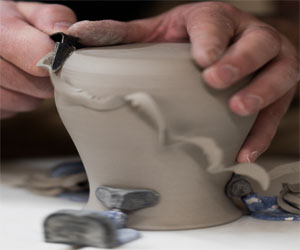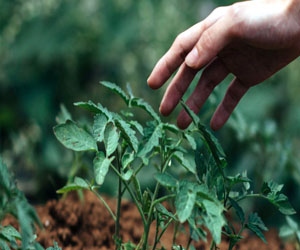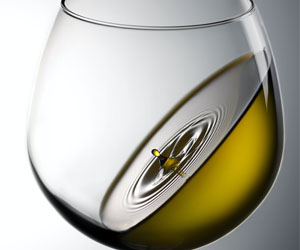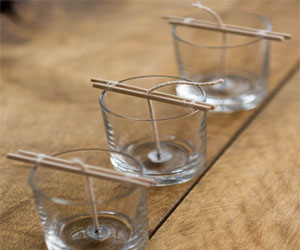


Creating Art From Earth

Pottery, the age-old craft of shaping clay into functional or decorative objects, has garnered a dedicated following of enthusiasts who pursue it as a fulfilling and creative hobby. Whether you're a novice or an experienced potter, engaging in pottery as a hobby offers a myriad of benefits and the opportunity to explore your artistic side.
1. Creative Expression: One of the most compelling aspects of pottery as a hobby is the chance to unleash your creativity. The malleability of clay allows for endless possibilities, from crafting everyday items like mugs and plates to sculpting intricate figurines or abstract art pieces. Your imagination is the only limit, and pottery provides a unique canvas for self-expression.
2. Stress Relief: Working with clay has a therapeutic effect. The tactile experience of manipulating the cool, moist material, combined with the meditative process of shaping, pinching, and molding, can help alleviate stress and promote mindfulness. As you immerse yourself in the creative process, daily concerns tend to fade away.
3. Sense Of Accomplishment: Completing a pottery project can be immensely rewarding. The tangible nature of the craft allows hobbyists to see the fruits of their labor take shape before their eyes. Whether it's the first pinch pot or a finely glazed vase, the sense of accomplishment is empowering and boosts self-esteem.
4. Functional And Decorative Items: Pottery offers a practical aspect as well. Hobbyists can create personalized, one-of-a-kind items for everyday use, such as plates, bowls, and utensils. These functional pieces can add a special touch to your home while showcasing your craftsmanship. Alternatively, pottery can be used to craft decorative items, making your living space uniquely beautiful.
5. Continuous Learning: Pottery is a hobby that offers endless opportunities for learning and growth. From mastering basic techniques like coiling, slab-building, and wheel-throwing to experimenting with glazes, there's always something new to discover. Experienced potters can push their boundaries by exploring advanced methods and complex forms.
6. Community And Connection: Pottery is often a social activity, and many enthusiasts find their way to local pottery studios or community centers to practice their craft. This opens the door to a community of fellow potters who share their passion. It's a great way to meet like-minded individuals and build connections through a shared hobby.
7. Preservation Of Tradition: Engaging in pottery as a hobby helps preserve an ancient tradition that spans countless cultures. As a potter, you become part of a lineage of artisans who have shaped and fired clay for thousands of years. You have the opportunity to carry forward and evolve this time-honored craft.
Whether you're seeking a therapeutic outlet, a creative journey, or simply a fun and satisfying hobby, pottery offers a unique and deeply rewarding experience. With the right tools, guidance, and a little patience, anyone can unlock the world of clay and embark on a journey of self-discovery and artistic expression through the wonderful realm of pottery. So, go ahead, get your hands dirty, and let the clay guide you on a creative adventure like no other.


Earth-Saving Crafts
 Environmental Impact
Environmental Impact
One of the most significant aspects of earth-saving crafts is their direct impact on the environment. By reusing materials, these crafts reduce the demand for new resources, saving energy and conserving raw materials. Crafting from waste materials not only lowers carbon footprints but also lessens the burden on landfills. It's a small, yet crucial, step toward mitigating the detrimental effects of overconsumption and waste generation.
Empowering Individuals
Engaging in earth-saving crafts is empowering. It fosters a sense of self-sufficiency and self-expression. Crafting allows individuals to take control of their environmental impact and make conscious choices. It encourages people to think outside the box and find new uses for old items, thereby reducing their reliance on mass-produced, environmentally-harmful goods.
Nurturing Nature And Your Garden
 The Essence Of Sustainability In Herb Cultivation
The Essence Of Sustainability In Herb Cultivation
Sustainable herb cultivation involves growing herbs in a manner that minimizes environmental impact, conserves resources, and promotes long-term garden health. This approach takes into consideration the entire lifecycle of the garden, from planting and maintenance to harvest and beyond.
Sustainable Herb Cultivation Practices
Organic Gardening: The foundation of sustainability in herb cultivation is organic gardening. Avoid synthetic pesticides and fertilizers, opting instead for natural and organic alternatives. This practice ensures that your herbs are free from harmful chemicals.
Water Conservation: Use water wisely by installing efficient irrigation systems like drip hoses or soaker hoses. Collect rainwater for irrigation to reduce dependence on municipal water supplies.
Composting: Create your compost heap to recycle kitchen scraps and garden waste. Compost enriches the soil, reduces the need for synthetic fertilizers, and minimizes landfill waste.
Crop Rotation: Implement crop rotation techniques to prevent soil depletion and minimize the risk of herb-specific diseases. Rotating herbs within your garden beds maintains soil health and vitality.
Beneficial Insects: Attract and support beneficial insects like ladybugs, bees, and butterflies. These insects help with pollination and natural pest control in your herb garden.
Crafting Unique Brews In Your Kitchen
 Homebrewers often find inspiration in their surroundings and experiences. They may draw from their local environment, incorporating indigenous ingredients or regional flavors into their brews. For instance, someone living near a citrus orchard might use fresh oranges in their recipe, imparting a distinct regional character to the beer. Such a creative approach not only results in delicious brews but also connects the beer to a specific place, making it a unique and memorable experience.
Homebrewers often find inspiration in their surroundings and experiences. They may draw from their local environment, incorporating indigenous ingredients or regional flavors into their brews. For instance, someone living near a citrus orchard might use fresh oranges in their recipe, imparting a distinct regional character to the beer. Such a creative approach not only results in delicious brews but also connects the beer to a specific place, making it a unique and memorable experience.
Experimentation is another cornerstone of homebrewing creativity. Homebrewers are constantly tinkering with their recipes, trying new techniques, and pushing the boundaries of what's possible. This willingness to take risks leads to the discovery of innovative flavor combinations and brewing methods. Whether it's aging beer in oak barrels, using wild yeast strains, or adding unconventional ingredients like herbs and spices, the homebrewing world thrives on experimentation.
Furthermore, the craft beer movement has been instrumental in driving homebrewing creativity. As craft breweries continue to innovate and develop new styles, homebrewers often follow suit. They adapt commercial trends and make them their own, experimenting with hazy IPAs, sour ales, and barrel-aged wonders. The exchange of ideas between professional brewers and homebrewers has enriched both communities, resulting in a diverse spectrum of beer styles and flavors.
Community plays a crucial role in fostering creativity among homebrewers. Beer enthusiasts often gather in local homebrew clubs, online forums, and social media groups to share their experiences, knowledge, and creative ideas.
Savoring The Subtle Pleasures
 Smell: The olfactory sense is crucial in wine tasting. Swirl the wine gently in your glass to release its aromas and then take a moment to inhale. Note the wine's bouquet, identifying various scents like fruit, flowers, spices, or oak. The aroma can provide insights into the wine's age, origin, and quality.
Smell: The olfactory sense is crucial in wine tasting. Swirl the wine gently in your glass to release its aromas and then take a moment to inhale. Note the wine's bouquet, identifying various scents like fruit, flowers, spices, or oak. The aroma can provide insights into the wine's age, origin, and quality.
Taste: This is the heart of the wine tasting experience. Start with a small sip, allowing the wine to coat your palate. Assess the wine's flavors, acidity, sweetness, and tannins. Look for complex layers of taste, from the initial impression to the finish. Consider the balance and harmony of the wine's components.
Touch: The tactile sensation of wine is an often-overlooked aspect. Assess the wine's body or weight on the palate. Is it light, medium, or full-bodied? The texture should be smooth and pleasing, with the right level of astringency from tannins.
Sound: While it might not be as prominent, the sound of wine plays a role in the overall experience. When you slurp the wine, the sound can provide clues about its viscosity and body. Experienced tasters often make a slight slurping sound to aerate the wine as it passes through their palate.
The Art Of The Swirl And Sip: The gentle swirl of the wine in the glass releases its aromas, allowing you to take in the full bouquet. This practice aerates the wine, which can enhance the aromas and flavors.
Taking small sips and holding the wine in your mouth allows for a thorough evaluation of its taste and texture. The art of wine tasting involves paying attention to the wine's complexity, noting the interplay of fruit, acidity, and tannins.
Exploring Candle Crafting Techniques
 Embedding: Embedding involves placing decorative objects (like dried flowers, seashells, or small figurines) within the candle as it cools and hardens. The objects are preserved within the candle, providing a unique, artistic touch.
Embedding: Embedding involves placing decorative objects (like dried flowers, seashells, or small figurines) within the candle as it cools and hardens. The objects are preserved within the candle, providing a unique, artistic touch.
Marbling And Swirling:
Marbled Candles: Achieve marbling effects by mixing various colored wax and gently swirling them together before pouring into a mold. The result is a candle with beautiful, intertwined patterns.
Swirled Candles: Create captivating swirl patterns by pouring different colored wax into a mold, then using a tool to create swirling designs before the wax solidifies.
Carving And Sculpting:
Carved Candles: Hand-carved candles are true works of art. After the candle has cooled and solidified, use carving tools to create intricate designs and patterns on the candle's surface.
Sculpted Candles: Sculpted candles involve shaping the wax while it's still soft and malleable. This technique allows for the creation of 3D designs and intricate shapes.
Aromatherapy And Scented Candles:
Aromatherapy Candles: Combine the art of candle making with the therapeutic benefits of aromatherapy. Infuse your candles with essential oils, such as lavender or eucalyptus, to create scented candles that promote relaxation and well-being.
Wax Embeds And Inclusions:
Wax Embeds: Add additional wax elements within your candles to create textural interest. These can be in the form of small wax chunks, flakes, or even finely grated wax that creates unique patterns within the candle.
Inclusions: Inclusions refer to adding non-wax elements like herbs, spices, or glitter to your candles. These inclusions can add a visual or aromatic dimension to your candles, making them truly one-of-a-kind.
Double Pour And Gel Candles:
Double Pour: This technique involves pouring a second layer of wax with a different color over an initial layer, creating a visually striking two-toned effect.
Gel Candles: Gel candles are made by using a clear, gel-like wax that allows for embedding decorative elements. The transparency of the gel enhances the visual appeal, making them perfect for decorative and gift candles.